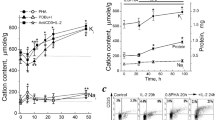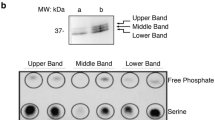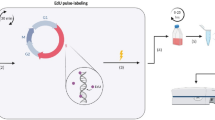Abstract
TRANSFORMATION of lymphocytes by antigens and by nonspecific mitogens (lectins and anti-immunoglobulin sera) is a consequence of the binding of the mitogen to specific receptors on the cell surface1–3. The receptors rapidly form clusters (‘patches’) which may aggregate into polar ‘caps’4 at higher mitogen concentration. These events initiate a series of biochemical changes—enhanced uptake of ions and metabolites1, increased cyclic GMP5, and increased metabolism of phosphatidyl inositol and other phospholipids (ref. 6 and V. C. M., M. J. Hayman and M. J. C., unpublished)—which culminate in DNA synthesis and mitosis 48–72 h later. Although the sequence, relative importance and control of these events is not yet defined, there is evidence for a primary role for Ca2+. Phaseolus vulgaris phytohaemagglutinin (PHA) initiates a slow accumulation of Ca2+ by lymphocytes7,8 and its stimulation of DNA synthesis is inhibited by citrate9, EDTA (ref. 9) or EGTA (ref. 10). The inhibition is reversed by Ca2+. It has also been shown that inhibition by the low concentrations (1.4 mM) of EGTA used did not prevent binding of PHA (ref. 11). Although these results showed Ca2+ to be an important factor in initiation of transformation it was not clear whether influx of Ca2+ was the only or even the main consequence of the binding of PHA.
This is a preview of subscription content, access via your institution
Access options
Subscribe to this journal
Receive 51 print issues and online access
$199.00 per year
only $3.90 per issue
Buy this article
- Purchase on Springer Link
- Instant access to full article PDF
Prices may be subject to local taxes which are calculated during checkout
Similar content being viewed by others
References
Greaves, M., and Janossy, G., Transpln Rev., 11, 87–130 (1972).
Allan, D., and Crumpton, M. J., Expl Cell Res., 78, 271–278 (1973).
Fanger, M. W., Hart, D. A., Wells, J. V., and Nisonoff, A., J. Immun., 105, 1484–1492 (1970).
Taylor, R. B., Duffus, W. P. H., Raff, M. C., and de Petris, S., Nature new Biol., 233, 225–229 (1971).
Hadden, J. W., Hadden, E. M., Haddox, M. K., and Goldberg, N. D., Proc. natn. Acad. Sci., U.S.A., 69, 3024–3027 (1972).
Fisher, D. B., and Mueller, G. C., Biochim. biophys. Acta, 248, 434–448 (1971).
Allwood, G., Asherson, G. L., Davey, M. J., and Goodford, P. J., Immunology, 21, 509–516 (1971).
Whitney, R. B., and Sutherland, R. M., Cell Immun., 5, 137–147 (1972).
Alford, R. H., J. Immun., 104, 698–703 (1970).
Whitney, R. B., and Sutherland, R. M., J. Cell Physiol., 80, 329–337 (1972).
Whitney, R. B., and Sutherland, R. M., Biochim. biophys. Acta, 298, 790–797 (1973).
Hamill, R. L., Gorman, M., Gale, R. M., Higgens, C. E., and Hoehn, M. M., 12th Intersci. Conf. Antimicrobial Agents Chemother., Abstract No. 55 and 56 (American Society Microbiology, Detroit, 1972).
Chaney, M. O., Demario, P. V., Jones, N. D., and Occolowitz, J. L., J. Am. chem. Soc., 96, 1932–1933 (1974).
Allan, D., Auger, J., and Crumpton, M. J., Expl Cell Res., 66, 362–368 (1971).
Biberfeld, P., Acta Path. Microbiol. Scand., Supplement, 223, 1–70 (1971).
Wong, D. J., Wilkinson, J. R., Hamill, R. L., and Horng, J., Archs Biochem. Biophys., 156, 578–585 (1973).
Katz, S., and Klotz, I. M., Archs Biochem. Biophys., 44, 351–361 (1953).
Claberek, S., and Martell, A. R., Organic sequestering agents (John Wiley, New York, 1959).
Caswell, A. H., and Pressman, B. C., Biochem. Biophys. Res. Commun., 49, 292–298 (1972).
Lehninger, A. L., Carafoli, E., and Rossi, C. S., Adv. Enzymol., 29, 259–320 (1967).
Roos, D., and Loos, J. A., Biochim. biophys. Acta, 222, 565–582 (1970).
Foreman, J. C., Mongar, J. L., and Gomperts, B. D., Nature, 245, 249–251 (1973).
Rasmussen, H., Science, 170, 404–412 (1970).
Walsh, D. A., Perkins, J. P., Bostrom, L. O., Ho, E. S., and Krebs, E. G., J. biol. Chem., 246, 1961–1967 (1971).
Huxley, H. E., Nature, 243, 445–449 (1973).
Yoshinaga, M., Yoshinaga, A., and Waksman, B., Proc. natn. Acad. Sci., U.S.A., 69, 3251–3255 (1972).
Schultz, G., Hardman, J. G., Schultz, K., Baird, C. E., and Sutherland, E. W., Proc. natn. Acad. Sci., U.S.A., 70, 3889–3893 (1973).
Kolata, G. B., Science, 182, 149–151 (1973).
Author information
Authors and Affiliations
Rights and permissions
About this article
Cite this article
MAINO, V., GREEN, N. & CRUMPTON, M. The role of calcium ions in initiating transformation of lymphocytes. Nature 251, 324–327 (1974). https://doi.org/10.1038/251324b0
Received:
Revised:
Issue Date:
DOI: https://doi.org/10.1038/251324b0
This article is cited by
-
FK 506: Effects on glomerular hemodynamics and on mesangial cells in culture
Kidney International (1995)
-
Effects of calcium channel modulators on the proliferation of mouse spleen lymphocytesin vitro
Agents and Actions (1990)
-
Suppression of mitogen- and antigen-induced lymphocyte proliferation by lanthanides
Experientia (1989)
-
Cytoplasmic calcium response to fluid shear stress in cultured vascular endothelial cells
In Vitro Cellular & Developmental Biology (1988)
-
Elevation of intracellular calcium reduces voltage-dependent potassium conductance in human T cells
Nature (1986)
Comments
By submitting a comment you agree to abide by our Terms and Community Guidelines. If you find something abusive or that does not comply with our terms or guidelines please flag it as inappropriate.



